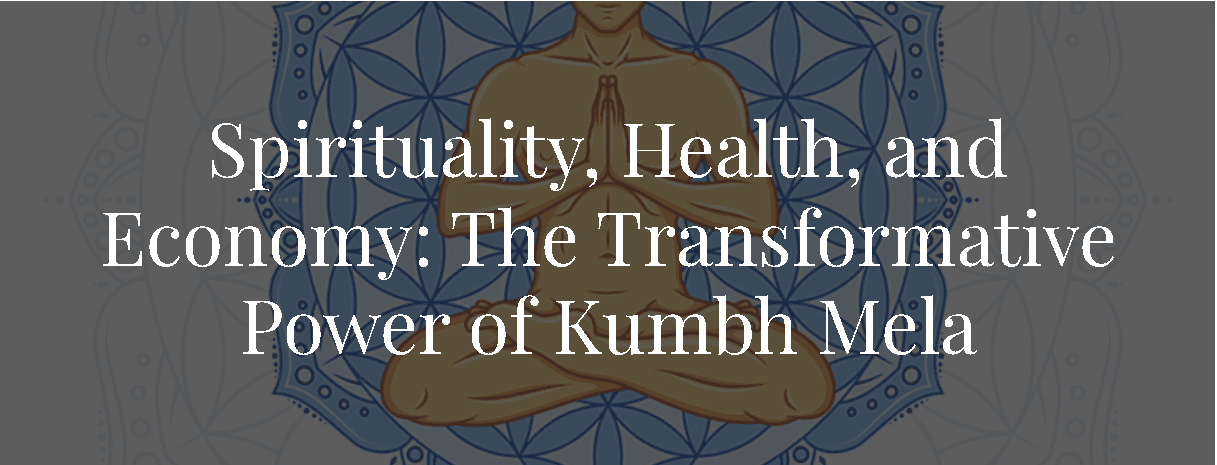
Spirituality, Health, and Economy:
The Transformative Power of Kumbh Mela
Spirituality, Health, and Economy:
The Transformative Power of Kumbh Mela
By Dr. Mannava Maruti Sarma
Maha Kumbha Mela is one of the largest religious gatherings globally, rooted in Hindu tradition. This pilgrimage occurs cyclically every 12 years at four sacred sites in India: Haridwar (Ganga River), Prayagraj (confluence of the Ganga, Yamuna, and Saraswati rivers), Nashik (Godavari River), and Ujjain (Shipra River). The festival's timing and location are determined by astrological alignments, primarily the positions of Jupiter, the Sun, and the Moon.
Historical Context: Maha Maha Kumbha Mela and Immunity
c. This ritual is considered transformative and is the event's main spiritual practice (Meyer, 2006). A key feature of the Mela is the presence of Sadhus and Ascetics, including the Naga Sadhus, who led austere lives and perform spiritual rituals. Their commitment to asceticism enhances the event’s deeply spiritual atmosphere (Sivaraman, 2009). The Mela is also marked by religious discourses and the singing of bhajans. Spiritual leaders deliver sermons, while devotional songs fill the air, adding to the event's sacred ambiance (Singh, 2014). In addition to the religious activities, the Maha Kumbha Mela showcases India's rich cultural heritage. Traditional rituals, art, and performances are displayed, reflecting the diversity and spiritual depth of Indian culture (Chakrabarty, 2017).
The health benefits of Maha Kumbha Mela are empirically supported, contributing significantly to both psychological and physiological well-being. The spiritual and religious significance of the festival provides a profound sense of tranquillity and existential purpose for participants, mitigating stress and enhancing psychological resilience. Research indicates that engagement in spiritual practices is associated with reductions in anxiety, depression, and emotional distress (Nolen-Hoeksema, 2012). The ritualistic practices, meditation, and spiritual discourses foster a heightened sense of connectedness and belonging, which can enhance mental and emotional health (Koenig, 2012). Moreover, the fasting and simplified lifestyle that many adherents adopt during the event can promote detoxification at the physiological level. This structured lifestyle, coupled with the emphasis on early morning rituals, contributes to overall homeostasis and health (Paliwal & Paliwal, 2014). The practice of immersing oneself in the sacred rivers, particularly in cold water, can be seen as a form of hydrotherapy, offering benefits such as improved circulatory function, skin rejuvenation, and overall physical invigoration. Lastly, Maha Kumbha Mela serves as a catalyst for social healing by uniting individuals from diverse socio-cultural backgrounds, fostering intergroup solidarity and reducing social fragmentation (Kahn, 2017).
From an economic perspective, Maha Kumbha Mela functions as a significant economic driver, particularly for the host regions. The event attracts millions of domestic and international pilgrims, thereby creating a substantial influx of tourism activity. This surge in visitors stimulates demand across multiple sectors, including hospitality, transportation, retail, and ancillary services, thereby catalysing local economic activity and job creation (Chand, 2012). The festival also generates substantial temporary employment opportunities in areas such as security, logistics, catering, health services, and retail (Sharma & Rai, 2018). Vendors specializing in religious paraphernalia, food, and handicrafts experience a direct economic benefit from the large volume of visitors. Furthermore, the scale of Maha Kumbha Mela often necessitates substantial infrastructure development, with government and private sector investments directed towards improving transportation, sanitation, healthcare, and public amenities to accommodate the influx of participants (Gokhale, 2014). These infrastructural upgrades often have long-term benefits, enhancing urban planning and quality of life for local residents (Desai & Desai, 2015). Ultimately Maha Kumbha Mela acts as a cultural and economic export, promoting Indian heritage on a global scale. The event fosters cultural exchange and attracts international media attention, thereby contributing to the global tourism economy and enhancing India’s soft power (Singh, 2016).
Maha Kumbha Mela is not merely a religious observance, but a multifaceted phenomenon that drives significant health benefits, fosters social cohesion, and acts as a potent catalyst for economic and infrastructural development in the host regions.
References:
- Chand, S. (2012). Tourism and its economic impacts: A case study of Kumbha Mela. Indian Journal of Tourism Research.
- Desai, M., & Desai, R. (2015). Infrastructure development and economic growth: Evidence from Kumbha Mela. International Journal of Regional Development.
- Gokhale, S. (2014). Maha Maha Kumbha Mela and urban development. Journal of Urban Studies.
- Kahn, J. (2017). Social healing at Kumbha Mela: A communal perspective. Sociology of Religion Review.
- Koenig, H. G. (2012). Religion, spirituality, and health: A review and update. Journal of Religion and Health.
- Nolen-Hoeksema, S. (2012). Emotion regulation and psychopathology: The role of gender. Annual Review of Clinical Psychology.
- Paliwal, A., & Paliwal, R. (2014). The health benefits of fasting and rituals: A study of Maha Maha Kumbha Mela participants. Indian Journal of Medical Research.
- Sharma, R., & Rai, A. (2018). Employment generation during religious festivals: A case study of Kumbha Mela. Journal of Economic Development.
- Singh, R. (2016). Global cultural exchanges through Kumbha Mela: An analysis of tourism impact. International Journal of Cultural Studies.
- Lochtefeld, J. G. (2010). The Illustrated Encyclopedia of Hinduism.
- Maclean, K. (2008). Pilgrimage and Power: The Kumbh Mela in Allahabad, 1765-1954.
- Meyer, M. (2006). The Kumbh Mela: A Spiritual and Cultural Phenomenon. Cambridge University Press.
- Sivaraman, R. (2009). The Sacred Pilgrimage: Sadhus and Their Practices. Journal of Hindu Studies, 12(3), 45-61.
- Singh, N. (2014). Devotional Music and Bhajans in Hindu Pilgrimages. South Asian Arts Journal, 25(2), 32-47.
- Chakrabarty, B. (2017). The Cultural Significance of the Kumbha Mela. Indian Cultural Review, 21(4), 12-28.


